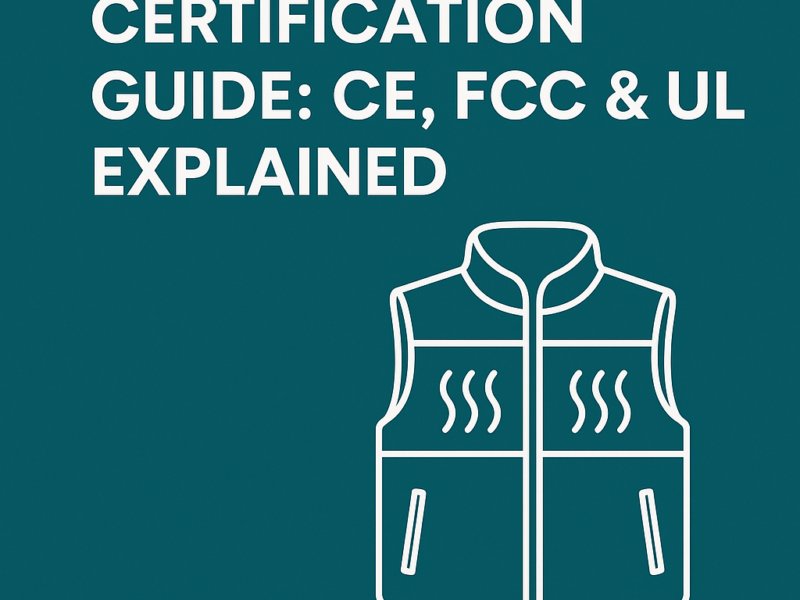
Why Heated Clothing Requires Certification
Heated apparel, such as vests, jackets, and gloves, combines textile materials with electronic components. This hybrid nature means it must meet both clothing safety and electronic safety standards.
Unlike regular outerwear, heated garments include:
- Lithium-ion batteries
- Electric heating elements
- Power regulation circuits
These parts bring the product under electronics safety, battery transport, and electromagnetic interferenceregulations—not just textile rules. Without proper heated apparel certification, products risk customs delays, retailer rejections, and platform takedowns.
United States Certification Requirements
1. UL (Underwriters Laboratories) – Safety testing for heating systems
- Not legally mandatory, but strongly recommended by major US retailers
- Improves consumer trust and reduces liability
2. FCC (Federal Communications Commission) – Electromagnetic compatibility
- Mandatory for all electronics sold in the US
3. UN38.3 – Lithium battery safety for air/sea transport
- Required for all shipments containing batteries
💡 Note: Amazon, Walmart, and REI suppliers often demand UL or equivalent certification before accepting heated apparel.
European Union Certification Requirements
1. CE-LVD (Low Voltage Directive) – For electronics under 50V (Required)
2. CE-EMC – Ensures electromagnetic compatibility (Required)
3. RoHS – Restricts hazardous substances (Required)
4. REACH – Controls chemicals in textiles (Recommended)
📌 YubinGlobal supports CE testing and can provide a Declaration of Conformity (DoC) for export.
Canada Certification Requirements
- CSA Certification – Canada’s equivalent to UL (Optional for low-voltage wearables)
- UN38.3 battery compliance is mandatory
- Some retailers require CSA or UL before stocking heated apparel
Japan & South Korea Certification Requirements
- PSE (Japan) – General electrical appliance safety
- KC (Korea) – Korean certification for electronics
- Local testing for batteries, heating circuits, and adapters required
Risks of Skipping Certification
- 📦 Customs holds or shipment returns
- ❌ Retailer rejection or blacklisting
- 🔥 Fire hazards and legal liability
- 👎 Amazon or Shopify listing removals
💬 Example: In 2024, one importer shipped 1,500 heated vests to Germany without CE marking. Customs held the shipment, fined €8,000, and returned the entire container.
Components That Require Testing
| Component | Common Certification |
|---|---|
| Battery Pack | UN38.3, MSDS, UL 2054 |
| Heating Elements | UL 499, IEC 60335 (optional) |
| Charger/Adapter | UL, CE, PSE, or KC |
| Finished Garment | CE (EMC + LVD), FCC, REACH |
How to Simplify Heated Apparel Certification
At YubinGlobal, we help clients:
- Use pre-tested heated modules with UL or CE compatibility
- Provide UN38.3 documentation for every battery batch
- Bundle CE/FCC/REACH documentation for ODM & OEM projects
- Work with third-party labs like SGS, TUV, Intertek
Even for small OEM batches, we streamline testing to meet global heated apparel certification standards.
Labeling & Documentation Checklist
Before shipping, ensure you have:
✅ Battery test reports (UN38.3 + MSDS)
✅ CE/FCC markings on product & packaging
✅ User manual in local language
✅ Compliance statement (DoC or SDS)
✅ Barcode and SKU traceability
Final Thoughts
Getting the right heated apparel certification is not just about passing tests—it’s about brand trust, retailer access, and avoiding costly setbacks.
Whether launching on Amazon or supplying global distributors, compliance is non-negotiable.
📩 Contact YubinGlobal for hassle-free certification and safe, market-ready heated clothing: info@yubinglobal.com

Recent Comments